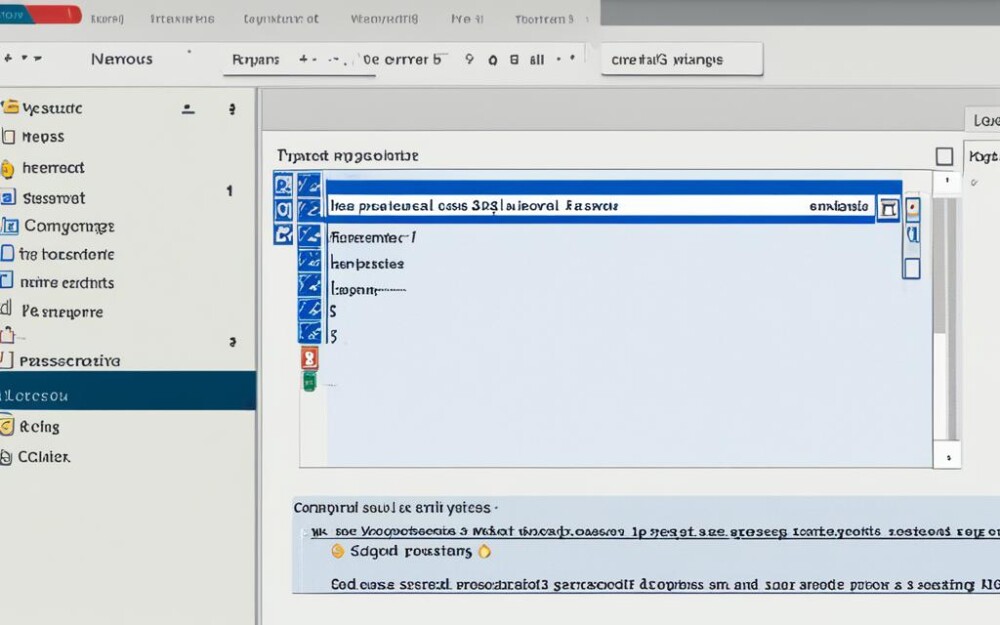Welcome to our detailed guide on fixing mysql_native_password loading mistakes in MySQL 8.4. If you struggle to access your MySQL database or face log-in issues, this guide is for you. Here, we’ll cover the common errors, why they matter, and how to fix them.
MySQL 8.4 stands as a leading database system used by many. However, you might run into problems like mysql_native_password loading errors. These errors can lock you out and slow down your database. It’s key to solve them fast to get back to full operation.
Key Takeaways:
To keep your MySQL system running smoothly, dealing with mysql_native_password loading errors is crucial. These errors can mess with your log-in and authentication.
Knowing the mysql_native_password authentication method well helps troubleshoot these errors. This knowledge is vital for efficient fixes.
Sorting out common load errors quicker comes with understanding and grouping them. It makes finding solutions and fixing them easier.
Wrong setup and using old plugins often lead to mysql_native_password loading errors. So, watch out for these issues.
- To ensure smooth functioning of your MySQL environment, it’s essential to resolve mysql_native_password loading errors in MySQL 8.4.
- Common errors may arise during the loading process, causing authentication problems and login issues.
- Understanding the mysql_native_password authentication method is crucial for troubleshooting related errors effectively.
- Identifying and categorizing common loading errors will help you diagnose and resolve them more efficiently.
- Incorrect configuration settings and outdated plugins are frequent causes of mysql_native_password loading errors.
Understanding mysql_native_password Authentication
In MySQL 8.4, many use the mysql_native_password authentication to connect securely and use databases. It’s key to know how this method works. This helps resolve any issues that might come up during use.
The mysql_native_password method uses a special formula to change passwords before saving them. This keeps important data safe. When someone tries to login, their password is compared to the safe version in the database. If they match, that person can access the system.
Yet, sometimes the mysql_native_password tool might not work, causing login troubles. These issues can be hard to fix without the right info.
When loading, many things can go wrong with mysql_native_password. Wrong settings, old tools, or issues between MySQL updates can cause trouble. This might stop someone from logging in or lead to errors.
To fix mysql_native_password issues, knowing how it works is crucial. This info helps spot and fix problems easier.
Next, we’ll look at common loading problems with mysql_native_password. We’ll give you tips to fix these issues.
Identifying Common mysql_native_password Loading Errors
In MySQL 8.4, it’s crucial to recognize and solve common mysql_native_password loading issues. These issues might stop MySQL from working. This can lead to problems logging in and authenticating.
Understanding the error messages and symptoms is key to fixing these issues. By knowing what to look for, you can work to get your MySQL running smoothly again.
One error message you might get is “Authentication plugin ‘mysql_native_password’ cannot be loaded.” This usually means there’s a problem between your MySQL version and the mysql_native_password plugin.
To fix these errors, updating the mysql_native_password plugin is very important. Making sure you have the newest version can solve many loading issues.
Sometimes, the error is about wrong passwords or user privileges. To solve this, check and reset your MySQL user accounts’ passwords. Make sure they have the right privileges to enter the database.
It’s crucial to carefully read and understand any error messages from MySQL. They often point to what’s wrong, helping you take the right steps to fix it.
Knowing about common mysql_native_password loading problems helps you easily troubleshoot and correct these issues. This way, you’ll be back to using your MySQL database without trouble.
Examples of Common mysql_native_password Loading Errors:
1. “Authentication plugin ‘mysql_native_password’ cannot be loaded.”
2. “Access denied for user ‘username’@’localhost’.”
3. “Incorrect password for user ‘username’@’localhost’.”
4. “ERROR 1524 (HY000): Plugin ‘mysql_native_password’ is not loaded.”
These messages often show that there’s a setup issue, like wrong settings or versions not matching. They can also mean there are problems with how users are logging in.
Resolving Incorrect mysql_native_password Configuration
Mysql_native_password loading errors in MySQL 8.4 often come from wrong settings. It’s important to get the settings right to avoid login problems and ensure the plugin works well. We will outline ways to troubleshoot and fix these configurations here.
Checking the Configuration Settings
To start fixing the mysql_native_password issue, check your settings. Find the MySQL configuration file like my.cnf or my.ini. This depends on your system.
Open the file with a text editor. Look for [mysql] or [mysqld]. Under this section, search for default-authentication-plugin.
If default-authentication-plugin doesn’t say mysql_native_password, it’s probably wrong. Change it to mysql_native_password and save the file.
Restarting the MySQL Service
After changing the settings, you must restart MySQL. This makes your updates work. How you do this depends on your system.
On Linux, using this command restarts MySQL:
sudo service mysql restart
For Windows, open Command Prompt as an admin. Type:
net stop mysql
net start mysql
Verifying the Correct Configuration
After restarting MySQL, make sure it’s configured right. Log in and run this SQL command:
SHOW VARIABLES LIKE 'default_authentication_plugin';
Image showing the steps to resolve incorrect mysql_native_password configuration
Following these steps can help you fix issues with mysql_native_password in MySQL 8.4. Always check and update settings as needed to keep MySQL running smoothly.
Updating mysql_native_password Plugin
To fix errors with mysql_native_password, ensure it’s updated in MySQL 8.4. Updating to the newest version helps remove old plugin errors. It also boosts security and performance in your MySQL system.
Here’s how to update the mysql_native_password plugin:
-
- Open your MySQL server with tools like MySQL Workbench or the command-line.
- Log in as an admin.
- Run this SQL to see the plugin version:
SELECT PLUGIN_VERSION FROM INFORMATION_SCHEMA.PLUGINS WHERE PLUGIN_NAME = 'mysql_native_password';-
- If it’s not the latest, find the newest version on the MySQL site or docs.
- Save the new plugin to a place your server can reach.
- Use this SQL to add the new plugin:
INSTALL PLUGIN mysql_native_password SONAME 'path/to/plugin.so';Change ‘path/to/plugin.so’ to the real folder path of the plugin you downloaded.
- To check the update, run the step 3 SQL command again. The version should match the newest one.
Updating the mysql_native_password plugin allows it to work well with MySQL 8.4. It fixes errors from old versions of the plugin. Staying up-to-date with the plugin makes your MySQL work smoothly and safely.
Troubleshooting Connection Issues in MySQL 8.4
Having trouble with connections in MySQL 8.4 can be really annoying. This often stops you from getting into your database. We’ll look at common issues and how to fix them here. These steps will guide you to solve log-in troubles and fix login errors in MySQL 8.4.
Diagnosing Connection Problems
Figuring out why you can’t connect is key. You should look for error messages or clues that point to login problems. Signs you’re having connection issues include:
- Failed login attempts
- Timeout errors
- Access denied messages
Seeing these signs likely means there’s a login problem blocking you.
Resolving Connection Issues
Once you know there’s a connection problem, it’s time to fix it. Here’s what to do:
- Check your login credentials: Make sure your username and password are right. Look out for typos.
- Verify host settings: The host settings need to be correct for connections. Check the host name, port, and connection.
- Review firewall settings: See if your firewall is stopping the connection. Change the rules to allow MySQL access.
- Restart MySQL service: Sometimes, restarting MySQL can fix things. Use the right command to do this.
- Test connectivity: Use the MySQL Command Line Client or MySQL Workbench to see if you can connect. This helps find specific issues.
The upcoming section will show how to get database access back when you see mysql_native_password loading errors in MySQL 8.4. You’ll get help with resetting your password, making sure your user account is okay, and getting the right privileges.
Restoring Database Access in MySQL 8.4
Are you seeing mysql_native_password loading errors in MySQL 8.4? Having a tough time getting back into your database? Don’t worry, we’ve got you covered. We’ll walk you through the steps to regain access, ensuring you can manage your database with ease.
Approach 1: Password Reset
Can’t log in because of password errors? Resetting the password might help. Follow these steps:
-
- Open the MySQL Command Line Client.
- Use this command to reset the password:
ALTER USER 'username'@'localhost' IDENTIFIED BY 'new_password';Don’t forget to change ‘username’ to your username and ‘new_password’ to your new password.
- Close the MySQL Command Line Client.
Approach 2: User Account Verification
Getting login errors because your account is unverified? Let’s make sure it’s verified. Here’s what you need to do:
-
- Access the MySQL Command Line Client.
- Enter this command to unlock the account:
ALTER USER 'username'@'localhost' ACCOUNT UNLOCK;Make sure to swap ‘username’ with your own username.
- Exit the MySQL Command Line Client.
Approach 3: Granting Appropriate Privileges
Not able to log in because your privileges are not enough? Grant the right privileges. Follow these steps:
-
- Open the MySQL Command Line Client.
- Use this command to give necessary privileges:
GRANT ALL PRIVILEGES ON database_name.* TO 'username'@'localhost';Change ‘database_name’ to the database’s name and ‘username’ to your username.
- Close the MySQL Command Line Client.
By using these methods, you can regain database access. You’ll soon have your MySQL 8.4 working smoothly again.
If the problems continue or you can’t fix the errors, keep reading. We’ll share more troubleshooting tips and best practices soon.
Securing mysql_native_password Authentication in MySQL 8.4
It’s essential to secure mysql_native_password authentication in MySQL 8.4. This helps protect your database from threats and unauthorized entry. By applying best practices, you can boost the safety of your MySQL setup.
Using Strong Passwords:
Start by making users create strong passwords. A robust password mixes uppercase, lowercase letters, numbers, and symbols. This makes it tough for hackers to get into your system without permission.
Enabling SSL Encryption:
Turning on SSL encryption adds a strong layer of security. It ensures information like passwords moves between clients and servers safely. This way, it’s harder for attackers to steal and read your data.
Implementing Two-Factor Authentication:
You should also think about adding two-factor authentication (2FA). It asks for more than just a password for entry, like a phone code. 2FA lowers the risk of unwanted access, keeping your system safer.
To sum up, securing mysql_native_password in MySQL 8.4 is key for database safety. Use strong passwords, SSL encryption, and 2FA to cut down on risks. This helps avoid authentication issues and security problems.
Preventing Future mysql_native_password Loading Errors
Now that you’ve fixed the mysql_native_password loading issues in MySQL 8.4, let’s look at avoiding them in the future. To keep your MySQL running well and prevent login and authentication troubles, follow these steps:
Regular Monitoring
It’s vital to watch your MySQL database often. This helps to catch loading or auth errors. Look at database logs, error messages, and how well it performs. Finding and fixing small problems can stop bigger ones later.
Timely Updates
Always update MySQL 8.4 with the newest fixes and patches. These updates help the software work better and safer. By staying current, you’ll lower the chances of having login or auth problems from old software.
Implement Robust Backup and Recovery Strategies
Setting up a strong backup plan is key to keeping your data safe. Regularly back up your databases to have a recent data copy. Also, check your backup plans often to make sure they’re ready for use.
Following these steps will cut down on mysql_native_password errors in MySQL 8.4. Regular checks, updates, and strong backup plans lead to a more stable MySQL. This means your users will have an easier time logging in and accessing data.
Conclusion
In this guide, we shared helpful tips to solve mysql_native_password errors in MySQL 8.4. With the steps we’ve outlined, fixing login problems and ensuring your database works well is easier.
To keep your database safe, always use security measures. This way, you’ll be able to manage any issues with mysql_native_password errors in MySQL 8.4 with confidence.


